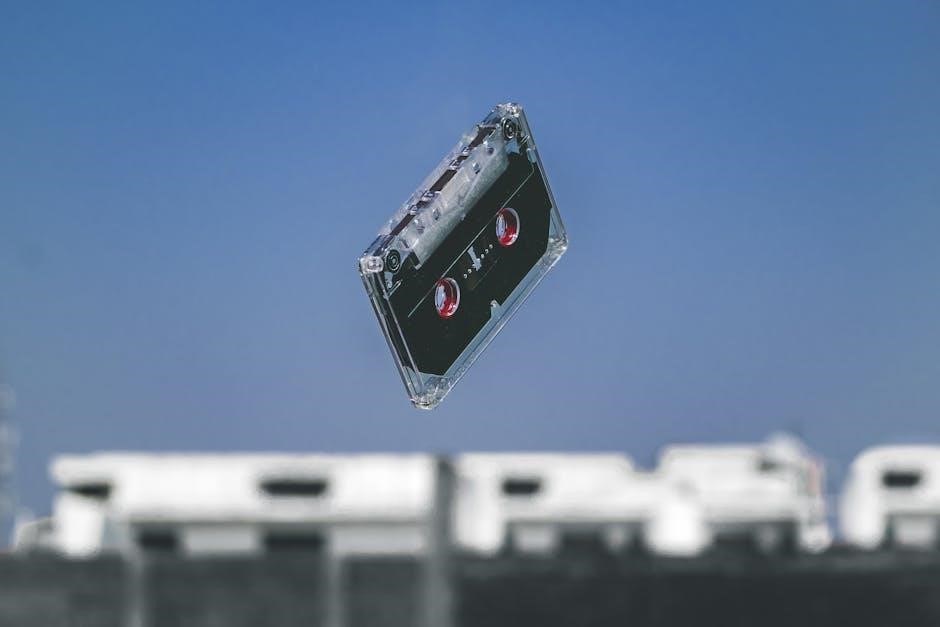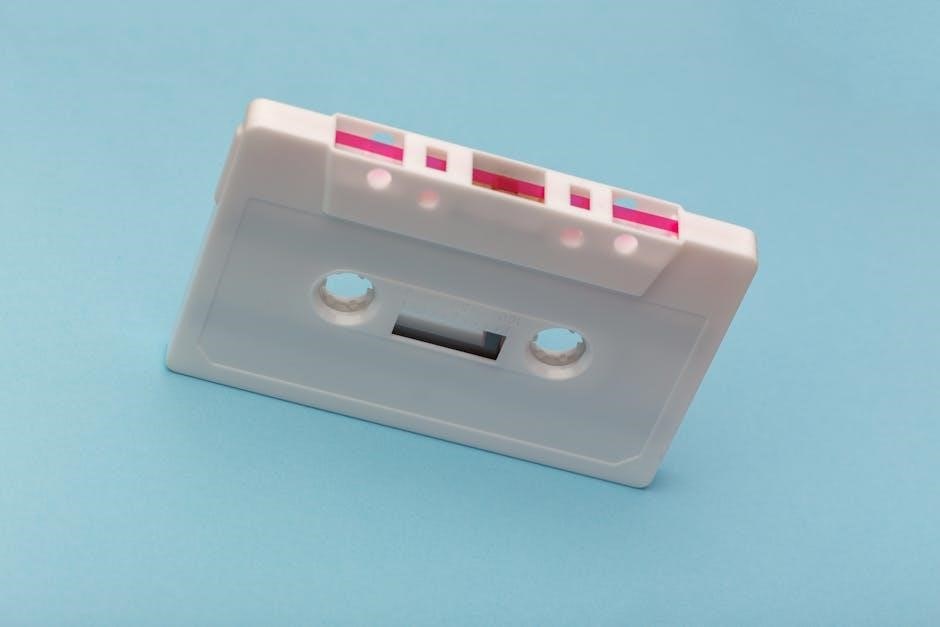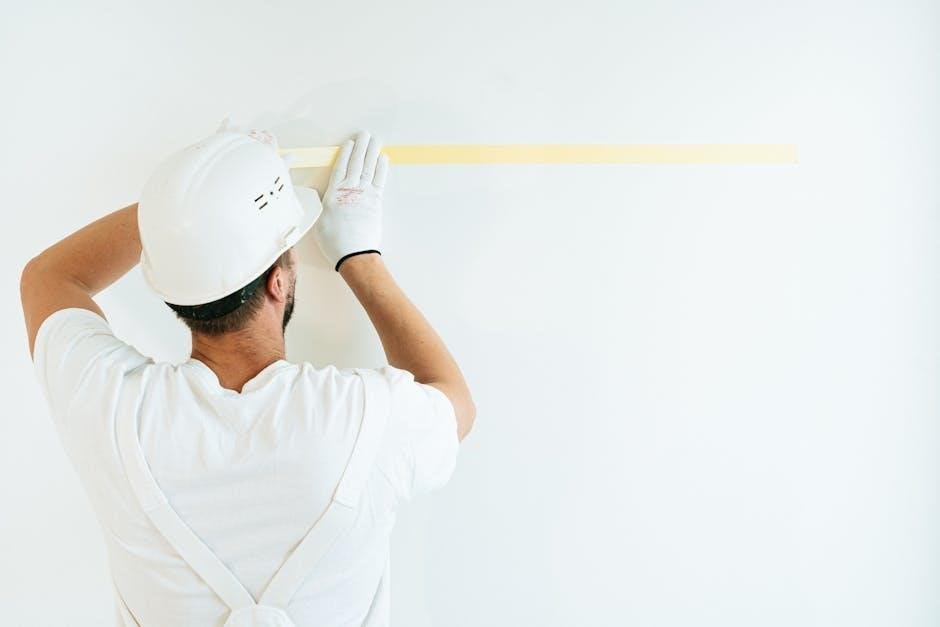KT Tape is a popular solution for Achilles tendonitis, offering elastic, breathable, and waterproof support. It promotes healing by enhancing circulation and providing stability, favored by athletes and therapists.
1.1. What is KT Tape?
KT Tape is an elastic, breathable, and waterproof kinesiology tape designed for therapeutic and supportive use. It is commonly used to relieve pain, reduce inflammation, and provide stability to injured areas. The tape is applied directly to the skin, creating a gentle lifting force that enhances blood flow and promotes healing. Available in rolls or pre-cut strips, KT Tape is popular among athletes and physical therapists for its durability and flexibility. It adheres well to sweaty skin and can last up to five days, even when exposed to water. Its versatility makes it a preferred choice for treating injuries like Achilles tendonitis.
1.2. Benefits of Using KT Tape
KT Tape offers numerous benefits, particularly for Achilles tendonitis. It provides pain relief by reducing stress on the tendon and surrounding tissues. The tape enhances blood circulation, promoting faster healing and reducing inflammation. Its elastic properties allow for a full range of motion, making it ideal for active individuals. KT Tape is waterproof and durable, lasting up to five days, even with showering or sweating. It is easy to apply and removes gently without causing skin irritation. The tape also offers prophylactic support, helping to prevent further injury. These benefits make KT Tape a versatile and effective solution for managing Achilles tendonitis discomfort and supporting recovery.

Understanding Achilles Tendonitis
Achilles tendonitis is inflammation of the Achilles tendon, causing pain and stiffness. It often results from overuse or repetitive strain, commonly affecting athletes and active individuals.
2.1. Definition and Overview
Achilles tendonitis is an inflammatory condition affecting the Achilles tendon, which connects the calf muscles to the heel bone. It causes pain, stiffness, and swelling, often due to overuse or repetitive strain. This common injury typically affects athletes and active individuals, disrupting daily activities and sports performance. If left untreated, it can lead to chronic issues or even tendon rupture. Early intervention is crucial to promote healing and prevent further damage. KT Tape is frequently recommended as a supportive measure to alleviate symptoms and enhance recovery. Understanding its definition and overview is essential for effective management and treatment.
2.2. Causes and Risk Factors
Achilles tendonitis is primarily caused by repetitive stress or overuse, leading to inflammation and degradation of the tendon. Risk factors include tight calf muscles, improper footwear, and excessive training. Activities involving running, jumping, or sudden changes in intensity increase susceptibility. Age-related tendon degeneration and poor warm-up routines also contribute. Additionally, individuals with flat feet or abnormal gait patterns are more prone to developing this condition. Addressing these factors is crucial for effective treatment and prevention, especially when combined with supportive measures like KT Tape to alleviate symptoms and promote healing.
2.3. Symptoms and Diagnosis
Achilles tendonitis typically presents with pain at the back of the heel, swelling, and stiffness, especially after physical activity. Symptoms may worsen with running or climbing stairs. Diagnosis involves a physical exam to assess pain and swelling, often complemented by imaging like ultrasound or MRI for tendon damage confirmation. Early stages may cause mild discomfort, while severe cases can lead to tendon rupture. Proper identification of symptoms is essential for effective treatment, including the use of KT Tape to alleviate pain and support the tendon during recovery. Early intervention is key to preventing progression and ensuring a full recovery.
2.4. Conventional Treatment Options
Conventional treatments for Achilles tendonitis include rest, ice therapy, and physical therapy to strengthen the calf muscles. Non-steroidal anti-inflammatory drugs (NSAIDs) may reduce pain and inflammation. Orthotics and footwear modifications are often recommended to alleviate stress on the tendon. In severe cases, corticosteroid injections or surgery may be considered. Additionally, stretching exercises and eccentric heel drops are commonly prescribed to improve tendon strength and flexibility. These methods aim to reduce pain, promote healing, and restore function, often complemented by supportive therapies like KT Tape for enhanced stability and circulation during the recovery process.

How to Apply KT Tape for Achilles Tendonitis
Prepare skin, cut Y-shaped strips, anchor under the heel, apply with 50% stretch up the Achilles, and finish without tension for support and pain relief.
3.1. Materials Needed
To apply KT Tape for Achilles tendonitis, you’ll need a roll or pre-cut strips of KT Tape, scissors, and clean, dry skin. Optional tools include a ruler or measuring guide for precise cuts. Ensure the tape has rounded corners to avoid irritation. A full 10-inch strip is often recommended for Achilles applications. For added comfort, consider using a hypoallergenic or waterproof version of the tape. Skin preparation products, like alcohol wipes, may also be useful to ensure proper adhesion. Always follow the manufacturer’s guidelines for cutting and applying the tape to achieve optimal results and avoid common mistakes.
3.2. Skin Preparation
Proper skin preparation is crucial for effective KT Tape application. Start by washing the affected area with soap and water to remove dirt, oils, and lotions, which can interfere with adhesion. Dry the skin thoroughly, as moisture reduces tape stickiness. Shave the area if necessary to ensure better contact. Trim toenails to prevent discomfort during application. Avoid applying lotions or creams 24 hours before taping. Ensure the skin is free of cuts or irritation; cover any open wounds with a bandage. Press the tape firmly onto the skin to activate the adhesive. Proper preparation ensures the tape stays in place longer, providing optimal support and pain relief.
3.3. Step-by-Step Application Guide
Start by preparing the skin and cutting the KT Tape into appropriate strips. Anchor a full strip under the arch of the foot without stretching. Apply another strip up the Achilles tendon with 50% stretch, starting from the heel. Lay the last two inches of this strip flat without tension. For added support, place a perpendicular strip over the area of pain, anchoring it in the middle. Finish by reinforcing with a final strip along the tendon. Ensure the tape is smoothed firmly to secure adhesion. This method provides targeted support, reduces pain, and promotes circulation for effective relief from Achilles tendonitis.
3.4. Tips for Effective Taping
For optimal results, apply KT Tape on clean, dry skin 10 minutes before activity. Rub the tape firmly to secure adhesion. Use 50% stretch on the Achilles tendon and avoid stretching the anchor points. Apply the tape in the direction of muscle fibers and smooth out any wrinkles or air bubbles. Round the corners to prevent peeling and press firmly for durability. Allow 24 hours before reapplying to avoid skin irritation. Use pre-cut strips for convenience and ensure proper alignment with the tendon. Plantar flex the foot during application for accurate placement. These tips ensure maximum support and pain relief for Achilles tendonitis.
3.5. Common Mistakes to Avoid
Avoid stretching the anchor points, as this can cause discomfort or reduce effectiveness. Do not apply tape with excessive tension, as it may restrict movement or cause skin irritation. Ensure the skin is clean and dry, and avoid applying tape over lotions or oils. Round the corners of the tape to prevent peeling and ensure smooth edges. Do not apply tape directly over open wounds or inflamed areas. Avoid using too much stretch on the Achilles tendon, as this can lead to discomfort. Press the tape firmly to secure adhesion but avoid excessive pressure. Proper application ensures better outcomes and prevents complications.

Different Taping Techniques
KT Tape offers various taping techniques, including preventative methods for injury prevention and therapeutic approaches for existing conditions. Techniques involve applying strips with or without stretch.
4.1. Preventative Taping
Preventative taping with KT Tape involves applying strips to support the Achilles tendon before physical activity; This technique helps reduce stress on the tendon, minimizing injury risk. By enhancing stability and circulation, it prepares the area for movement. Clean, dry skin is essential for optimal adhesion. Applying the tape without stretch at the heel and gently stretching it up the tendon provides a protective barrier. Rounded corners prevent peeling, ensuring durability. This method is ideal for athletes or individuals engaging in high-impact activities, offering a proactive approach to injury prevention and long-term tendon health. Regular use can enhance performance and safety.
4.2. Therapeutic Taping for Injuries
Therapeutic taping with KT Tape is a widely used method to support injured Achilles tendons. It involves applying strips to reduce pain and inflammation while promoting healing. The tape is applied with a 50% stretch over the affected area, providing gentle compression to relieve tension. This technique helps improve circulation, which accelerates recovery. Continuous use of KT Tape can alleviate discomfort and strengthen the tendon during daily activities or rehabilitation. It is particularly effective for mild to moderate injuries, offering a non-invasive solution to manage symptoms. However, it should not be applied on severe swelling or open wounds, as this may worsen the condition.

Benefits of KT Tape for Achilles Tendonitis
KT Tape reduces pain, enhances circulation, and provides stability to the Achilles tendon, aiding recovery and preventing further injury during physical activity or rehabilitation.
5.1. Pain Relief and Reduction
KT Tape effectively alleviates pain associated with Achilles tendonitis by reducing stress on the tendon. The elastic properties of the tape provide gentle compression, which helps decrease inflammation and discomfort. When applied correctly, it lifts the skin, enhancing blood flow and promoting healing. This mechanical support reduces pressure on the tendon, offering immediate pain relief during activities. The tape’s ability to distribute force more evenly across the affected area minimizes discomfort, allowing individuals to remain active. Many users report significant pain reduction, making KT Tape a preferred non-invasive solution for managing Achilles tendonitis symptoms during both rehabilitation and daily activities.
5.2. Support and Stability
KT Tape provides exceptional support and stability for the Achilles tendon, helping to protect it from further strain. The tape acts as a secondary layer of skin, offering structural reinforcement that allows the tendon to heal without compromising mobility. By stabilizing the area, KT Tape reduces excessive movement that could exacerbate the injury. This support is particularly beneficial for individuals engaged in physical activities, as it helps maintain proper alignment and reduces stress on the tendon. The tape’s elastic properties enable it to absorb and redistribute forces, providing continuous stability and preventing overstretching, which is crucial for recovery and preventing further injury.
5.3. Enhanced Circulation
KT Tape enhances circulation to the Achilles tendon, promoting healing and reducing inflammation. The elastic properties of the tape create a gentle lifting effect on the skin, which helps improve blood flow. This increased circulation delivers oxygen and nutrients to the injured area, accelerating the recovery process. While scientific evidence on circulation improvement is mixed, many users report reduced swelling and faster healing, suggesting that KT Tape can aid in enhancing blood flow to the tendon. Improved circulation is particularly beneficial for Achilles tendonitis, as it supports the natural repair mechanisms of the body. This benefit is often highlighted in user success stories and clinical applications of KT Tape.

Contraindications and Precautions
KT Tape should not be applied on open wounds, infected areas, or severe swelling. Avoid use with severe pain or sensitive skin. Consult a professional before application.
6.1. When Not to Use KT Tape
KT Tape should not be used on open wounds, infected areas, or skin with severe irritation. It is also contraindicated in cases of severe swelling, active inflammation, or allergic reactions to adhesives. Individuals with sensitive skin may experience discomfort, so a patch test is recommended. Additionally, KT Tape should not be applied over areas with impaired circulation or during acute injury phases where swelling is pronounced. Proper skin preparation and medical consultation are advised before application to ensure safety and effectiveness.
6.2. Potential Risks and Side Effects
While KT Tape is generally safe, potential risks include skin irritation, allergic reactions to the adhesive, or discomfort from improper application. Some users may experience mild redness, itching, or blistering, especially if they have sensitive skin. In rare cases, overstretching the tape can cause nerve or tendon irritation. It is crucial to follow application guidelines and perform a patch test before first use. If irritation occurs, discontinue use and consult a healthcare professional. Adverse effects are typically mild and temporary, but precautions ensure optimal outcomes for Achilles tendonitis treatment.

Integrating KT Tape with Other Treatments
KT Tape complements stretching, strengthening exercises, physical therapy, and orthotics, enhancing Achilles tendonitis recovery by providing continuous support and promoting healing when used alongside other therapies.
7.1. Stretching and Strengthening Exercises
Stretching and strengthening exercises are essential for managing Achilles tendonitis, especially when combined with KT Tape. Gentle stretches like calf stretches and heel raises improve flexibility, while strengthening exercises, such as toe raises and resistance band workouts, enhance tendon resilience. KT Tape supports these exercises by providing stability and reducing strain on the tendon. Together, they promote circulation, reduce pain, and accelerate recovery. Regular stretching and strengthening routines, paired with KT Tape, help restore tendon function and prevent future injuries, making it a comprehensive approach for active individuals seeking to maintain mobility and strength during rehabilitation.
7.2. Physical Therapy and Rehabilitation
Physical therapy and rehabilitation play a vital role in treating Achilles tendonitis, often complemented by KT Tape. Therapists design personalized programs focusing on range-of-motion exercises, muscle activation, and functional movements. KT Tape enhances these therapies by providing structural support, reducing pain, and improving circulation. Techniques like soft tissue mobilization and ultrasound therapy, combined with taping, promote tendon repair and restore mobility. Rehabilitation aims to strengthen the lower limb, improve gait mechanics, and prevent re-injury. Integrating KT Tape into physical therapy sessions offers patients a non-invasive, effective solution to manage symptoms and accelerate recovery, ensuring a smoother transition back to normal activities and sports.
7.3. Orthotics and Footwear
Orthotics and footwear are essential components in managing Achilles tendonitis, complementing KT Tape’s benefits. Custom orthotics redistribute pressure, correct foot mechanics, and reduce strain on the Achilles tendon. Proper footwear with adequate arch support and cushioning minimizes stress during activities. Combining orthotics with KT Tape enhances stability and pain relief, promoting a faster recovery. Footwear should ideally have a rigid heel counter and flexible sole to support the tendon. By addressing biomechanical issues, orthotics and appropriate footwear, alongside KT Tape, create a comprehensive approach to treating Achilles tendonitis, ensuring long-term relief and preventing recurrence. This combination is particularly beneficial for active individuals seeking sustainable recovery solutions.

KT Tape Application Guide PDF
The KT Tape Application Guide PDF provides step-by-step instructions for taping Achilles tendonitis, including methods, tips, and resources for effective pain relief and support.
8.1. Where to Find the PDF Guide
The KT Tape Application Guide PDF for Achilles tendonitis can be found on the official KT Tape website, as well as through medical supply websites and sports therapy resources online. Many physical therapy clinics and sports medicine websites also offer downloadable versions of the guide. Additionally, some retailers that sell KT Tape products provide access to the PDF as a complementary resource. It’s advisable to ensure the guide is sourced from a reputable provider to guarantee accuracy and safety in application techniques.
8.2. How to Download and Use the Guide
To download the KT Tape Achilles Tendonitis PDF guide, visit the official KT Tape website or authorized medical supply sites. Once downloaded, open the PDF and review the step-by-step instructions. The guide includes visual aids and detailed taping techniques. Print the guide for easy reference during application. Ensure your device has a PDF reader installed. Follow the illustrated steps carefully, starting with skin preparation and ending with proper tape anchoring. Use the guide alongside professional advice for optimal results; Regularly update your guide to access the latest taping methods and tips for effective Achilles tendon support and pain relief.

Case Studies and Success Stories
A 22-year-old athlete with chronic Achilles pain experienced significant relief and improved mobility after consistent KT Tape application, validating its effectiveness in real-world scenarios.
9.1. Real-World Applications
KT Tape has been widely used by athletes and individuals with Achilles tendonitis to alleviate pain and enhance performance. Application guides, such as the KT Tape Achilles Tendonitis PDF, provide step-by-step instructions for taping techniques that target the affected area. These methods include anchoring the tape under the arch, applying strips with 50% stretch over the Achilles tendon, and finishing without stretch to ensure comfort and support. The tape is designed to reduce pressure on the tendon, allowing individuals to engage in physical activities without discomfort. Many users report improved mobility and reduced pain, making KT Tape a practical solution for everyday use and sports.
9.2. Success Stories from Users
Many users have reported significant relief from Achilles tendonitis pain using KT Tape. Athletes and individuals alike share testimonials of how the tape provided necessary support, allowing them to resume physical activities without discomfort. One user mentioned that after applying the tape as per the PDF guide, they experienced reduced inflammation and improved mobility. Another highlighted that the tape helped them return to running and cycling without pain. These success stories underscore the effectiveness of KT Tape in managing Achilles tendonitis, offering both immediate relief and long-term support for an active lifestyle. The tape’s ability to enhance circulation and reduce tension has made it a trusted solution for many.

Scientific Evidence and Research
Studies by Y. Sugino and El Khoury highlight KT Tape’s effectiveness in reducing pain and improving function for Achilles tendonitis. Research supports its benefits for athletes and active individuals.
10.1. Studies on KT Tape’s Effectiveness
Research indicates that KT Tape can significantly reduce pain and improve function in individuals with Achilles tendonitis. A study by Y. Sugino found that the tape improves circulation, while El Khoury’s work highlighted its role in reducing tendon strain. These findings suggest that KT Tape not only alleviates symptoms but also supports injury prevention during physical activities. Additionally, case studies on athletes demonstrate improved performance and faster recovery when using KT Tape. Overall, scientific evidence supports the effectiveness of KT Tape for managing Achilles tendonitis, making it a valuable tool for both therapeutic and preventative care;
10.2. Evidence Supporting Pain Reduction
Multiple studies and clinical trials demonstrate KT Tape’s effectiveness in reducing pain associated with Achilles tendonitis. Research by Y. Sugino and El Khoury highlights its ability to alleviate discomfort while enhancing circulation and tendon support. Case reports and user testimonials further corroborate these findings, showing consistent pain relief. The tape’s elastic properties allow for sustained comfort during movement, making it a preferred choice for athletes and individuals with active lifestyles. These findings underscore KT Tape’s role as a non-invasive, effective solution for managing pain in Achilles tendonitis, supported by both scientific evidence and real-world applications.
KT Tape effectively supports Achilles tendonitis by reducing pain and enhancing circulation. Its ease of application and durability make it a recommended solution for active individuals seeking relief.
11.1. Summary of Key Points
KT Tape is a highly effective solution for managing Achilles tendonitis, offering pain relief, enhanced circulation, and stability. Its elastic design provides support during physical activities while promoting healing. The tape is easy to apply, waterproof, and durable, making it ideal for athletes and individuals with active lifestyles. Regular use can reduce discomfort and prevent further strain on the tendon. Combined with other treatments like stretching and physical therapy, KT Tape is a versatile tool for managing Achilles tendonitis effectively. Its non-invasive nature and ease of use make it a recommended option for those seeking relief from tendon-related pain.
11.2. Encouragement to Try KT Tape
KT Tape offers a non-invasive, effective solution for Achilles tendonitis, providing pain relief, improved circulation, and enhanced support. Its ease of application, durability, and versatility make it an excellent choice for both athletes and non-athletes. By applying KT Tape, individuals can reduce discomfort and regain mobility, allowing them to return to their active lifestyles. With its waterproof design and long-lasting adhesion, KT Tape is a practical and reliable option for managing Achilles tendonitis. Encourage yourself or others to try KT Tape today and experience the benefits of targeted support and pain relief, helping you stay active and healthy.
